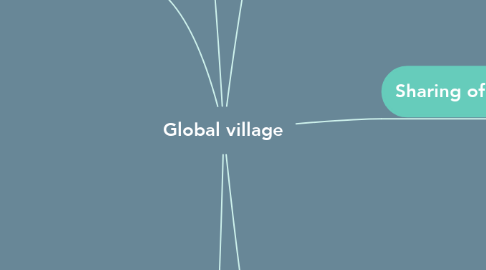
1. Economic globalization
1.1. The global marketplace :
1.1.1. Several corporate household names exemplify current global trends.
1.1.2. International free trade => directed by global agreements
1.1.3. Factors delay the process of globalization: cultural discrepancies, household rules and language barriers.
1.1.4. The developed world => dominate the process of globalization.
1.1.5. The difference between people => less important
1.1.6. Economic power -> not necessarily dictate policy
1.2. Competition and protection • Advocates of free trade vs barrier trade • Role of exchange rate fluctuations in business success or failure • Globalization => pushed limitations in consumerism forward
2. The shrinking planet
2.1. People in the past:
2.1.1. • Have few communicative devices for all people • They just know about immediate surroundings
2.2. Changes with profound effect
2.2.1. • Explosive population • Technology, tourism, internet development • Many new industries
2.3. Globalization do not affect to human peculiarities People try to maintain their own culture and their own taste.
3. Community & Conflict
3.1. No inherent conflict between being a good global citizen & being a proud member of a particular regional
3.1.1. A person may regard himself as a European or an African => such multi-layering of identities is common
3.1.2. Humans long to be part of a group, while insisting on their individuality. The habit of treating a different
3.1.3. The propensity to violent conflict seems well-honed
3.2. Ethnic divisions have not vanished but many gradually diminish under the influence of globalization
3.2.1. • Code and Pepsi’s multi-ethnic customers • Teenagers’ global culture • Sport ‘s unifying and polarizing effect
3.3. Urbanization has accelerated the trend of multi-cultural society,
3.3.1. • In OECD countries almost 80% of the population live in towns. • New ideas and fashions - and diseases - spread fast in cities.
3.4. a change in the transition to patterns of employment
3.4.1. • Technology enables more products to be made by computer-controlled machines.
3.4.2. • In the UK and USA, farmworkers now make up less than 3% of the workforce.
3.4.3. • Services already account for 70% of employment in the USA.
3.5. The labor force has been influenced due to immigrants
3.5.1. In Australia, foreign-born workers make up 24% of the total labor force.
3.5.2. The US has about 25 million foreign-born residents, accounting for about 9% of the workforce.
3.6. The world is more prone to conflict than it used to be is hard to say.
3.6.1. + A famine in remote Sudan + Today's wars can be watched live on television,
3.7. CMC is being used in more and more countries as a way to enhance democracy.
3.7.1. 200 cities worldwide have civic networking projects experimenting
3.7.2. an Internet-based information exchange with different levels of access in Germany
3.8. how to enforce national law in the global village
3.8.1. Law enacted to protect people and the environment
3.9. Cultural diversity is one of the glories of human civilization
3.9.1. Chiapas Indians, using caricature blond wigs and pale-faced masks
4. Global village
4.1. Origin: the array of new technology Village conditions: the myriad differences
4.2. Encouragement of economic globalization: • Popular distribution of local specifications • Change in consumers’ buying habits
4.3. Economic management in global village: • Rich countries: are exposed to economic domination • Poor countries: can create new tensions
4.4. Some problems: the disengagement of the global ,financial system, no effective supranational institutions & no effective police force.
5. Sharing of sovereignty
5.1. Background knowledge: Globalization breaks down system of nation states.
5.1.1. Cooperation occurred 50 years ago: families -> tribes -> nations -> regional power blocs -> a single world political community.
5.2. The United Nations which is the chief among international organizations seems to be unable to tackle the world’s most intractable issues
5.2.1. UN offers forum to exchange views/ deal with virtual rules (mail delivery, aircraft, food & industrial goods, etc.)
5.3. Despite having competitions, nations can still reach an agreement on a joint basis
5.3.1. Agree (in 1986) on a majority voting system to advance the single market
5.3.2. EU got agreement by 11 of its 15 member states to stabilize economic & monetary union
5.4. UN has minimal impacts on resolving serious political conflicts, but valuable functions in smoothing international relations
5.4.1. A kind of global village: with a combination of 185 member countries
5.4.2. The UN assembly appears to be more representative than The UN Security Council however, its power is less.
5.5. EU - typical example of shared sovereignty
5.5.1. Agreement on use of a single currency, the euro, by 11 of 15 member
5.5.2. Western Europe - integrated economic & strong political ties.
5.5.3. Leading in environmental protection
6. Converging or Diverging
6.1. Reality/ Reason for the trend toward Western model
6.1.1. Countries want to achieve economic success
6.1.2. Practices: + Accept free market + monetary discipline -> improve living standards + Adopt World Bank – driven ‘structural adjustment programme’ + Privatising state-owned companies
6.1.3. Rising Living standards, life expectancy and educational norm >< wider social gap
6.2. Globalization creates convergence among most countries/people
6.2.1. India: change from self-sufficiency to more integration with world economy
6.2.2. North Korea: severe food shortages and economic decline attract foreign investment
6.3. The globalised world makes countries diverging.
6.3.1. Tourism is somehow of hindrance in culture retention as local festivals
6.3.2. ‘Fast food’ commercialization is encouraged
6.3.3. Overload tourists suppressed receiving community, local youths are influenced in a negative way
6.4. The excluded society
6.4.1. Poverty and ignorance rule out the global high-tech economy.
6.4.2. Power over information and invention has always been confined to elites.
6.4.3. Optimists argue that the result will be better education, more 'opportunity
